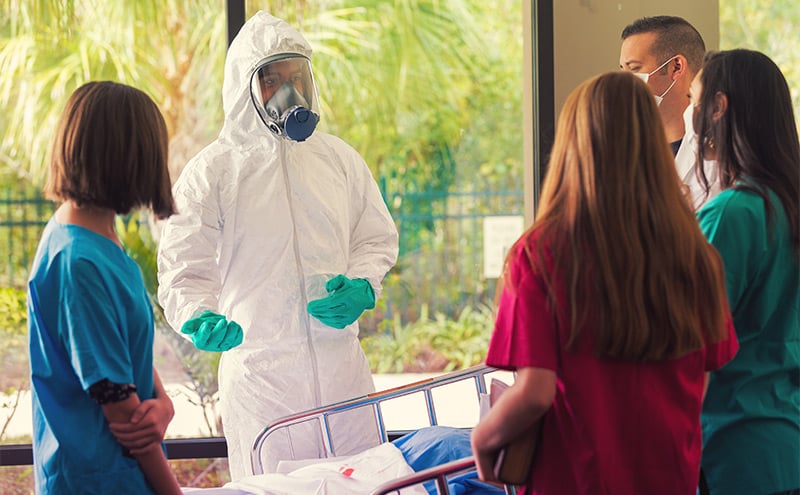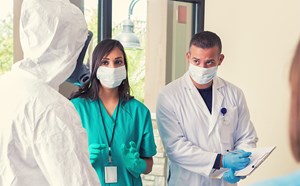
Introductory Training and References
Disaster Classifications (Level 1, 2, and 3)
Disasters are categorized into three Levels namely; minor, major and catastrophic disasters. The distinctions between disaster levels are described below:
- Minor Disaster: Any disaster that falls within the response capabilities of Local Government and requires minimal State or Federal assistance.
- Major Disaster: Any disaster that exceeds the local government capabilities and requires a broad range of State and Federal assistance.
- Catastrophic Disaster: Any disaster that require massive State and Federal assistance, including immediate military involvement. Potential Federal assistance will involve response as well as recovery measures.
Disaster Related Definitions
Common Terms
The world of disaster response is full of acronyms, terms, and agencies and can be challenging to medical professionals that are just becoming involved in disaster planning. Listed below are a few of the more common definitions frequently used in medical disaster planning. Knowing these definitions, and the background associated with them can be beneficial when being introduced to disaster planning world, and with the development of response plans.
All-Hazards - "The spectrum of all types of hazards including accidents, technological events,natural disasters, terrorist attacks, warfare, and chemical, biological including pandemic influenza, radiological, nuclear, or explosive events." (DHS, Fed. Cont. Direct. 1, 2007, p. P-1)
A comprehensive listing of these terms and definitions, and other information is available on the FEMA website.
Download a copy of the Guide.
Assistant Secretary for Preparedness and Response (ASPR), HHS - The Office of the Assistant Secretary for Preparedness and Response (formerly the Office of Public Health Emergency Preparedness) serves as the Secretary's principal advisory staff on matters related to bioterrorism and other public health emergencies. ASPR also coordinates interagency activities between HHS, other Federal departments, agencies, and offices, and State and local officials responsible for emergency preparedness and the protection of the civilian population from acts of bioterrorism and other public health emergencies. (ASPR Website)
CBRNE - Chemical, Biological, Radiation, Nuclear and Explosive Weapons.
Civil Defense - "All those activities and measures designed or undertaken to:
- minimize the effects upon the civilian population caused or which would be caused by an enemy attack on the United States;
- deal with the immediate emergency conditions that would be created by any such attack; and
- effectuate emergency repairs to, or the emergency restoration of, vital
utilities and facilities destroyed or damaged by any such attack." (Dept. of Army, WMD-CST Operations, Dec. 2007, Glossary-9)
Decontamination - "The removal of dangerous goods from personnel and equipment to the extent necessary to prevent potential adverse health effects... (DOT, Emergency Response Guidebook…Hazardous Materials Incident, 2004, 360)
Disaster - An event that requires resources beyond the capability of a community and requires a multiple agency response.
Emergency Management - The process by which the uncertainties that exist in potentially hazardous situations can be minimized and public safety maximized. The goal is to limit the costs of emergencies or disasters through the implementation of a series of strategies and tactics reflecting the full life cycle of disaster, i.e., preparedness, response, recovery, and mitigation. (Drabek1997)
HAZMAT - "Any substance or material in a quantity or form which may be harmful to humans, animals, crops, water systems, or other elements of the environment if accidentally released. Hazardous materials include: explosives, gases (compressed, liquefied, or dissolved), flammable and combustible liquids, flammable solids or substances, oxidizing substances, poisonous and infectious substances, radioactive materials, and corrosives." (EPA, Technical Guidance for Hazards Analysis, 1987, p. A-5)
Mass Casualty - "Any large number of casualties produced in a relatively short period of time,usually as the result of a single incident such as a military aircraft accident, hurricane, flood, earthquake, or armed attack that exceeds local logistic support capabilities." (DoD, DOD Dictionary of Military and Related Terms, 2007)
Mass Casualty Event - "…a catastrophic public health- or terrorism-related event, such as influenza pandemic or the detonation of improvised nuclear devices, the resulting tens of thousands of victims will be likely to overwhelm the resources of a community’s health care system." (AHRQ, Mass Medical Care with Scarce Resources, February 2007, p. viii)
Educational Resources
There are a variety of places to find educational material related to the medical response to a disaster. Listed below are resources from ACEP, governmental and other educational institutions. More listings will become available in the future.
Federal Government Educational Resources
- Centers for Disease Control (CDC)
- In a Moment’s Notice: Surge Capacity in Terrorist Bombings (PDF)
- Tips for Coping With Stress
U.S. Department of Health and Human Services
Federal Emergency Management Agency (FEMA)
Non-Governmental Educational Resources
- The National Disaster Life Support Foundation (NDLSF) offers a variety of courses to obtain all-hazards disaster medicine training.
Government Role in Disaster
Federal vs. State
Stafford Act - The Robert T. Stafford Disaster Relief and Emergency Assistance Act. This Act constitutes the statutory authority for most Federal disaster response activities especially as they pertain to FEMA and FEMA programs.
Emergency Support Functions - Present the missions, policies, structures, and responsibilities of Federal agencies for coordinating resource and programmatic support to States, tribes, and other Federal agencies or other jurisdictions and entities when activated to provide coordinated Federal support during an incident. There are 15 ESFs that the Federal government uses to support its response to a disaster, they are:
- ESF #1 - Transportation
- ESF #2 - Communications
- ESF #3 - Public Works and Engineering
- ESF #4 - Firefighting
- ESF #5 - Emergency Management
- ESF #6 - Mass Care, Emergency Assistance, Housing, and Human Services
- ESF #7 - Logistics Management and Resource Support
- ESF #8 - Public Health and Medical Services
- ESF #9 - Search and Rescue
- ESF #10 - Oil and Hazardous Materials Response
- ESF #11 - Agriculture and Natural Resources
- ESF #12 - Energy
- ESF #13 - Public Safety and Security
- ESF #14 - Long-Term Community Recovery
- ESF #15 - External Affairs
Disaster Declaration Primer - This downloadable PDF document gives an overview of the disaster declaration process from local governments to Presidential request.
Terrorism Awareness for Emergency Responders
WMD/Terrorism Awareness for Emergency Responders Online - Learn more here
Bombings: Injury Patterns and Care
Bombings: Injury Patterns and Care curriculum was developed through the Linkages of Acute Care and EMS to State and Local Injury Prevention Programs project that was funded by the Centers for Disease Control and Prevention (CDC). The American College of Emergency Physicians (ACEP) served as the lead grantee for this project.
The curriculum was developed with the assistance of a task force that included representative experts from emergency medicine including physicians, surgeons, nursing, and EMS. Bombings: Injury Patterns and Care curriculum is designed to be the minimum content that should be included in any all-hazards disaster response training program. This content is designed to update the student with the latest clinical information regarding blast related injuries from terrorism.
CDC Releases Blast Injury Mobile Application
The Centers for Disease Control and Prevention (CDC) recently announced the release of a new Blast Injury mobile application to assist in the response and clinical management of injuries resulting from terrorist bombings and other mass casualty explosive events. The application provides clear, concise, up-to-date medical and healthcare systems information to assist healthcare providers and public health professionals in the preparation, response, and management of injuries resulting from terrorist bombing events.
Medical Record Abstraction Form for Domestic Bombing Events
Data capture regarding the diagnosis and treatment of injuries is important to quantify the true impact of a disaster. This one-page form allows public health personnel, at the city, county, state, or federal level, to quickly extract basic medical information from hospital and emergency medical services’ records in order to advise officials as to the immediate impact of the event and the potential need for special resources (e.g., blood products, types of medical personnel, etc.).
Download the Medical Record Abstraction Form.
Blast Injuries: Fact Sheets for Professionals - Centers for Disease Control & Prevention (CDC)
These fact sheets address background, clinical presentation, diagnostic evaluation, management and disposition of blast injury topics. The fact sheets may be viewed and downloaded for use in the treatment of blast injury patients, in the training of clinical staff or to disseminate to others. Topics include: Blast Injuries: Essential Facts; Injury Care: Prehospital; Lung Injury: Prehospital Care; Lung Injury; Radiological Diagnosis; Crush Injury and Crush Syndrome; Post Exposure Prophylaxis for Bloodborne Pathogens; Abdominal Injuries; Extremity Injuries; Ear Injuries; Eye Injuries; Thermal Injuries; Pediatrics; Older Adults; and Bombings and Mental Health.
- Abdominal Blast Injuries
- Prehospital Care
- Crush Injury and Crush Syndrome
- Ear Blast Injuries
- Essential Facts
- Blast Extremity Injuries
- Eye Blast Injuries
- Blast Lung Injury
- Blast Lung Injury: An Overview for Prehospital Care Providers
- Bombings and Mental Health
- Treatment of Older Adults
- Pediatrics
- Post Exposure Prophylaxis for Bloodborne Pathogens
- Radiological Dispersal Devices and Radiation Injury
- Radiological Diagnosis
- Thermal Injuries
- Traumatic Brain Injuries
- Field Triage Decision Scheme (PDF)
Blast Injuries Audio Podcast Now Available on the CDC’s Website
Bombings: Injury Patterns and Care Class Material
- 1 Hour Course Presentation via Webinar
- Instructor – Led 1 Hour Course Presentation V2.0 (PowerPoint)
- Blast Curriculum Three Hour Seminar (Word)
- Blast Curriculum Three Hour Seminar in Spanish (Word)
- Bombings Three Hour Seminar (PowerPoint Presentation)
- Bombings Three Hour Seminar in Spanish (PowerPoint Presentation)
Download the one-hour interactive course - The full Flash course (Flash player required) can be downloaded and run on your computer.
Instructions: Download compressed file to your computer. Extract the files to a folder on your computer. Then open the folder and click the file named Start to begin the application.
Bombings: Injury Patterns and Care Pocket Guide - free pocket guide available for download. This guide can be printed on 8 1/2" x 14" paper.
This project was supported by Cooperative Agreement Number U38/CCU624161-01-3107 from the U.S. Centers for Disease Control and Prevention (CDC).
The following information addresses the background, clinical presentation, diagnostic evaluation, management and disposition of blast injury topics, including Essential Facts; Injury Care: Prehospital; Lung and Abdominal Injuries; Extremity Injuries; Ear Injuries; Eye Injuries; Thermal Injuries; and Bombings and Mental Health.
Responding to Disaster
Many physicians are interested in becoming a part of disaster response team. This streaming video presentation explains how to become a member of a disaster response team and how the experience will change you forever.



